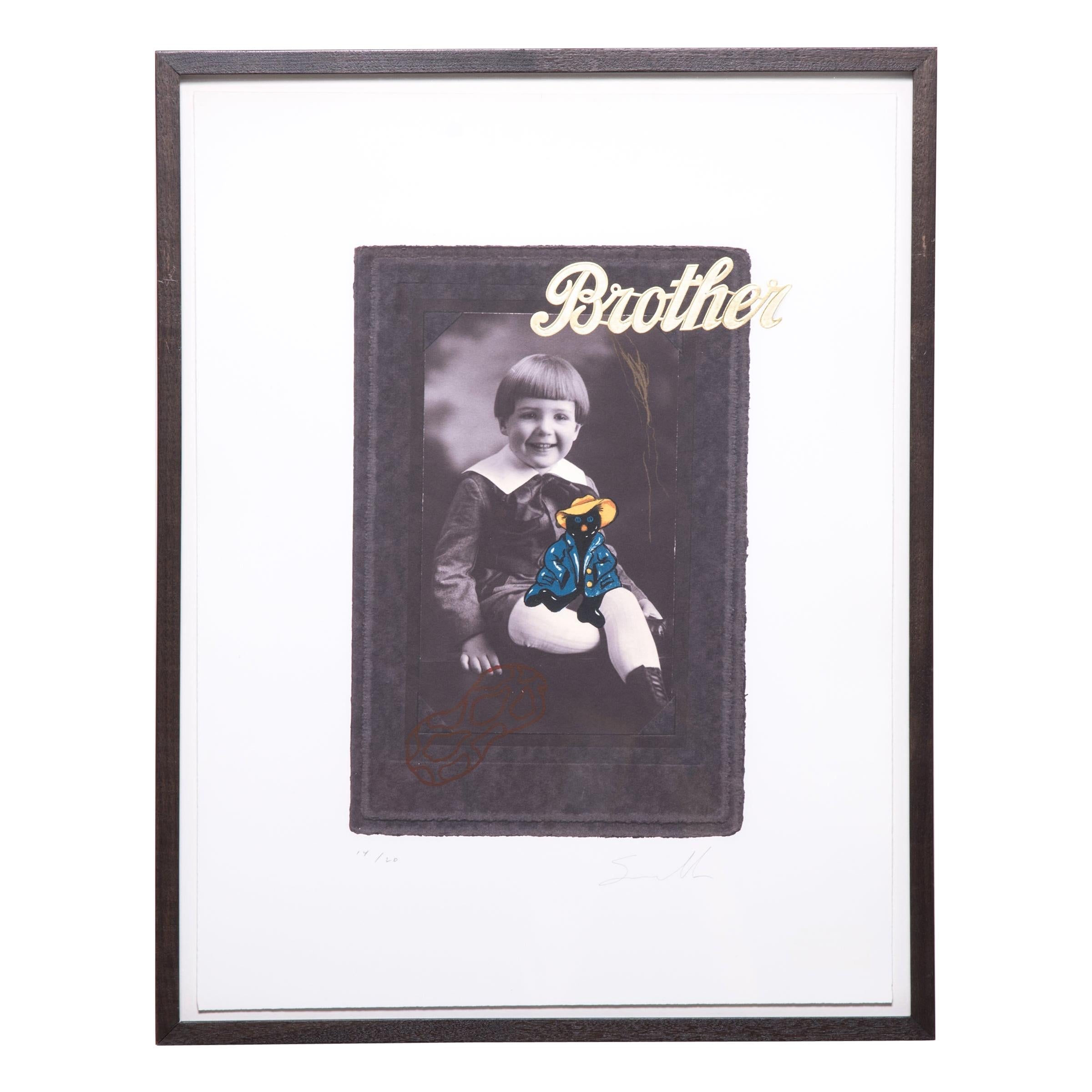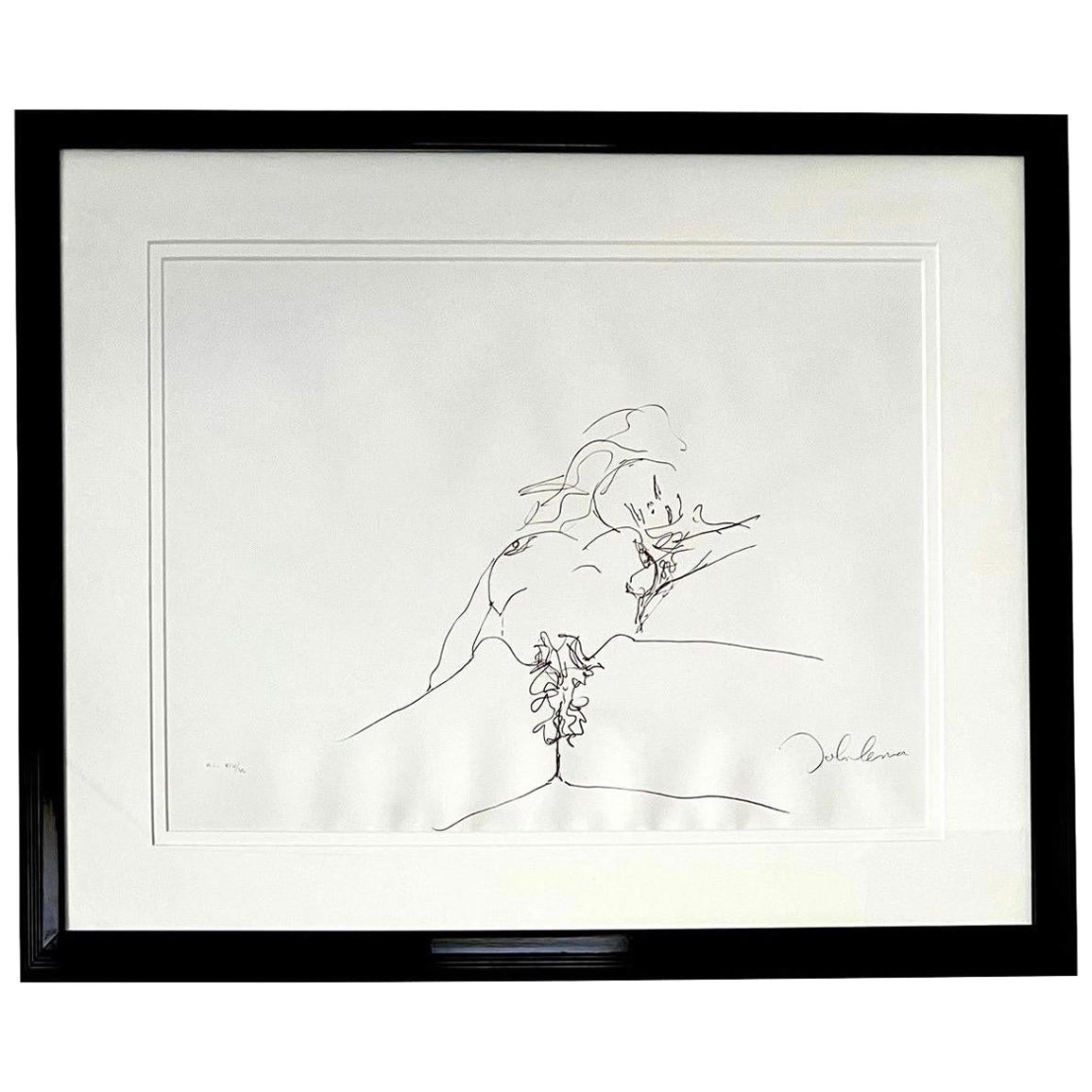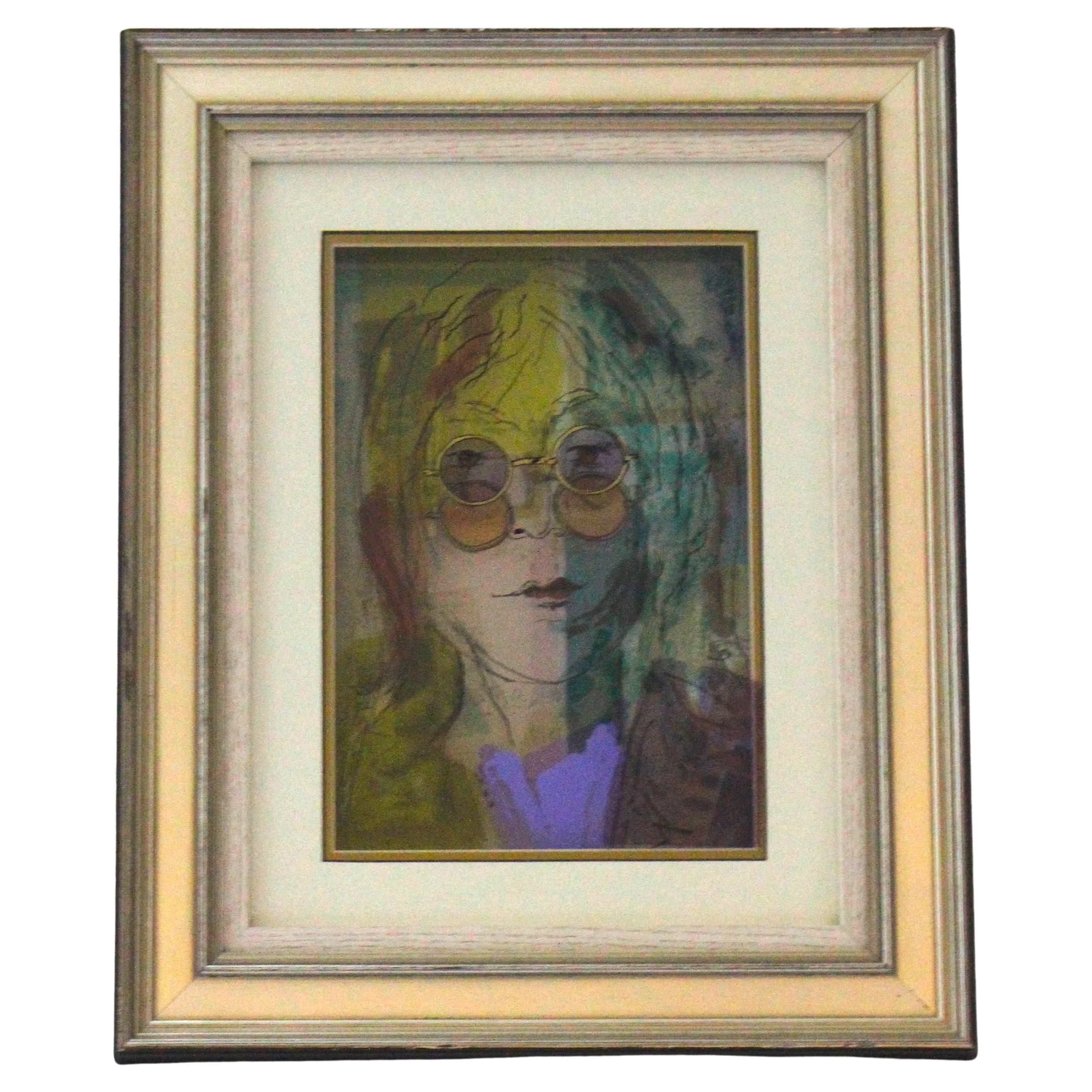Items Similar to John Somerville ARTWORK JOHN LENNON SCULPTURE BUST signed by artist : unique
Want more images or videos?
Request additional images or videos from the seller
1 of 18
John Somerville ARTWORK JOHN LENNON SCULPTURE BUST signed by artist : unique
About the Item
JOHN LENNON
BUST IN RESIN
1984
signed by artist
height: 64cms ~width: 36cms ~ depth: 30cms
weight: 9.6kg
artwork is in immaculate perfect condition
- free shipping worldwide -
John Somerville (born 1951), attended Woodhouse Grammar School and Barnet College in north London.
He studied Fine Art Bronze Casting under David Reid (Leverhulme Fellowship, Central St Martin's School of Art) and opened his first bronze studio in 1979.
He has had numerous one-man shows in the UK, Europe and the United States.
He exhibits regularly at the Royal Academy Summer Exhibition. His work appears regularly at Christie's and Sotheby's auction houses in London and New York.
Commissions include rock stars in bronze for the Hard Rock Cafes in New York, Houston, Los Angeles, Hawaii and Reykjavík; public monuments and commemorative busts.
In 2016 John completed a statue of Spike Milligan sitting on a bench for Avenue House Estate Trust at Stephens House and Gardens in Finchley,
which is the product of over ten years of work and fundraising by the Finchley Society.
youtube: " MAKING LONDON John Somerville interview "
- Dimensions:Height: 25.2 in (64 cm)Width: 14.18 in (36 cm)Depth: 14.97 in (38 cm)
- Style:Mid-Century Modern (Of the Period)
- Materials and Techniques:
- Place of Origin:
- Period:1980-1989
- Date of Manufacture:1984
- Condition:
- Seller Location:Kumhausen, DE
- Reference Number:1stDibs: LU8587235592482
About the Seller
5.0
Gold Seller
These expertly vetted sellers are highly rated and consistently exceed customer expectations.
1stDibs seller since 2023
9 sales on 1stDibs
Typical response time: 2 hours
- ShippingRetrieving quote...Ships From: Bodenkirchen , Germany
- Return PolicyA return for this item may be initiated within 10 days of delivery.
More From This SellerView All
- Art Deco Tea Service by Carstens Uffrecht ar 1930 uranium glaze + cups + platesBy Carstens TönnieshofLocated in Kumhausen, DEA Tea Service by CARSTENS UFFRECHT 1930s (and not Carstens Tönnieshof which emerged from this company and was founded later) Serie HAWAI All items on photos are included in this off...Category
Vintage 1930s German Mid-Century Modern Tea Sets
MaterialsPottery
- SET of SIX mid-century STOOLS by Günter Talos Vienna or pin legs ar. 1950By Günter TalosLocated in Kumhausen, DESix mid-century stools designed and made in Vienna around 1950 by J. A. Talos, Vienna XII. Bezirk , Dörfelstraße 6-8 . The architectually significant and quite representative building is still existing and under monument protection - the company existed until between 1976 and 1978 according the senior Owner the Cabinet Maker Anton Griessler - just opposite the road who´s son was so kind to give me those informations on the phone. - ... we love to do researches ! designed by Günter Talos. The company produced high quality iron furniture and was having the honour in taking part in the Werkbundausstellung 1930 The triangular seat is covered with its original red leatherette and as a special featuret they have a solid round and rounded straight chromed ornament in its middle - solid steel chromed hairpin legs Vintage condition is very good with some signs of age. Dimensions: Width 40cm Depth 40 cm Height 46 cm Seat height 46 cm. Weight: 4.5 Kg / each shipped in 2 custom made boxes 3 stools each for a maximum of safety For people interested in the fascinating Viennese History of Art / Art and Design of the early 20th Century: Werkbund Exhibition 1930 Werkbund Vienna The Werkbund Wien was an association of artists, industrialists and craftsmen that split off from the Österreichischer Werkbund, founded in 1912, in 1921 under the leadership of Josef Hoffmann and reunited with it in May 1928. The latter was dissolved by the National Socialists in 1938. History In 1920, on the occasion of an exhibition in the Vienna Museum of Art and Industry, the fundamental discussion flared up again as to whether the Austrian Werkbund should be oriented towards arts and crafts or whether serial, industrial production based on artistic designs should be the decisive factor. This discussion had been initiated by the art critics Arthur Rössler and Hans Tietze; the latter spoke of "a thousand cute things...Category
Vintage 1950s Austrian Mid-Century Modern Stools
MaterialsIron, Chrome
- 1950s wing back arm chair & ottoman extremely comfy solid make beech exc conditLocated in Kumhausen, DEextremely comfortable Western German 1950s wing back arm chair + footstool in very good A++ condition solid beech high class firm spring upholstery please feel free to ask for a ...Category
Vintage 1950s German Mid-Century Modern Living Room Sets
MaterialsFabric, Beech
- Karl Nothhelfer very rare SET of 2 Wingback Armchairs & Sofa 1950s solid CherryLocated in Kumhausen, DEjust beautiful SET of Sofa & 2 Wingback Armchairs by Prof. Karl Nothelfer - Designed in 1957 maker: Schörle & Gölz in Stuttgart - Bad Cannstatt solid Cherry Wood new upholstery and fabrics in 1998 according to last owner ( since then just in use for 2 years so upholstery is perfect ! ) Seatrests can be removed - and fixed by clips on belts - high class - measurements: easy chair is 70cm wide ~ sofa is 178cm wide both: seating height 40cm ~ seating depth: 57cm condition - all firm and in very good condition - no damages furniture have fully been accurately cleaned :: - 3 steps: A: air pistol - B: industrial hoover - C: latest Kärcher "wash&hoover" technology - woods have been polished several times note: please ask for shipping quote by sending us your postcode/destination Prof. Karl Nothelfer * 14 June 1900 ~~ + 20 May 1980 Since the beginning of the 15th century, the Nothelfer family of carpenters has been continuously resident in the former town of Überlingen without interruption. Every carpenter at that time mastered all the possibilities of woodworking: so did the Nothelfer. They could carpenter, even carve altars and figures, and set them in gold, silver and paint. (churches in Owingen and Hödingen]. Some family members lived and worked and worked in Hedingen or Hödingen,like today the jubilarian Karl Nothelfer (this in 1975). His father, Karl Anton Nothelfer, as the eldest of seven siblings, was able to take over his father's carpentry business in Überlingen. Karl Anton Nothelfer, the eldest of seven siblings, was unable to take over his father's carpentry business in Überlingen. He instead moved to the industrial town of Singen with his young wife Rosalie, née Hanner, from the from Hohenzollern in 1896 and moved to the former Poststraße and founded his own carpenter's workshop. He had a highsense of quality and form and was already a member of the German Werkbund before 1914. Karl Nothelfer and his three siblings grew up in such air. After attending school and the secondary school in Singen, the young Karl learned the carpenter's trade in his father's workshop then moved on to the Badische Landes-Kunstschule in Karlsruhe, where he studied architecture. At that time the well-known furniture professor also worked there Fritz Spannagel, born in Freiburg in 1891, who settled in 1938 at Ittendorf Castle near Meers- burg (died 1957). In 1928, the gifted young architect received a teaching assignment at the at the Karlsruhe School of Art, but followed his teacher Spannagel to Berlin in the same year. Berlin. Here he worked from 1928-1945 as a teacher - appointed professor in 1931 - at the Berlin Tischler-Schule, the later Bauschule für Raumgestaltung. The furniture he created in Berlin became internationally known through many exhibitions and lectures. nationally known and influential. His furniture creations ushered in a new era in German and a new era in German and European furniture design. At the world exhibition in Paris 1937 Prof. Nothelfer was awarded the Golden Medal for his work in the furniture sector. for his work in the furniture sector. A first summary and balance of his work on furniture is given in his standard work 1942 published standard work "Das Sitzmöbel", the first compendium of its kind in the world. world. In 1950 he published his second work "Furniture". Both books and a series of brochures were published by Verlag Otto Maier, Ravensburg. Karl Nothelfer continued to work intensively on the design of seating furniture in the years after 1945. In 1950 he succeeded in the important invention of the two-legged skid-base chair, which has been orthopedically - anatomically tested thousands of times - has become accepted all over the world today. Even the most distinguished American furniture companies such as Miller or Knoll-International use the skid as the main theme for desks and chairs. At the same time, N. had a groundbreaking in the redesign of German school furniture and seating for industry. industry. He succeeded in adapting his furniture forms, which originated in wood and handicraft, to the modern technical modern technical possibilities of the industry. He thus became the great refor- of schoolroom furnishings. The architect Nothelfer thinks about himself, that he made his main contribution in the field of seating furniture, although this was not was not really his profession. After the war, Prof. Nothelfer, like so many others, had to start all over again. He settled settled in his home town of Lake Constance in Hödingen in 1945 as a freelance architect and was and was involved in all areas of construction in the years after the war. As early as 1935, he had given many the example of American prefabricated buildings and recommended serial house and recommended it at a time when no one in Germany was even thinking about mass production. Now he developed he developed several types of mass-produced houses, which were manufactured in Baiersbronn. of which more than 800 houses were built in France alone (types Paris, Provence, Normandie). were built. At that time [1946], as part of the reparations in Strasbourg, there was an exhibition of houses with Swedish, Danish, and French designs. with Swedish, Danish, Finnish, English and German houses, where the French occupation for which 6 different types were sent from the French occupation zone, the Nothelfer's house type was considered the top of this exhibition. Karl Nothelfer was also involved in the development of chipboard. In 1946, together with others in Munich, he founded the first magazine "Bauen und Wohnen" ("Building and Living") after the war and remained its co-editor for many years. co-editor of this magazine for many years. By presenting his own work, he has here interpreted what the essence of the magazine wanted to be: Building, in order to live in it, in order to live as a human being and humanly in the built. Karl Nothelfer planned his houses furniture ground plan, from the need for living. In 1948 he was appointed honorary senator of the State Building school in Holzminden. Karl Nothelfer did not build much in Singen. The first post-war house was Haus Fahr on the slope of the Hohentwiel (Domäne); the building material came from a demolished log house that a French officer had built for himself on the Schie- nerberg. nerberg. In 1952, he also built the administration building of the aluminum rolling mill in Singen. rolling mills in Singen, with relief and wall painting by C. G. Becker. In Überlingen he built In Überlingen he built, among others, the Buchinger Sanatorium, the Riese+ Hähnel radio house and various reconstructions in the old town: Haus Kitt with the Glockenspiel, the Haus mit dem Bacchus in the Überlingen village, the Dolphin Fountain in Hödingen (1975). Probably the most beautiful Haus Nothelfers, the Haus Himmelheber, stands in Baiersbronn-Tonbach. On the airfield Mengen, Nothhelfer built the casino building with the 30 square meter faience painting Ikarus by C. G. Becker. In 1954 he founded a second office with architect Hans Schwingen in Düsseldorf. Office, which primarily fertilized the housing construction, true to the motto:from the inside to planning from the outside. The Minister of Housing awarded a prize to the best social housing in North Rhine- Westphalia; it was from the Nothelfer+Schwingen studio in Düsseldorf. Also the idea of new idea of home ownership was also promoted by Nothelfer+Schwingen. promoted by Nothelfer+Schwingen. On the occasion of the red jubilee of the law about condominium ownership Nothelfer gave a lecture in Essen in 1961 on condominium ownership in Europe (published as a brochure). published as a brochure]. From Düsseldorf, among many others, in the silk city...Category
Vintage 1950s German Mid-Century Modern Living Room Sets
MaterialsFabric, Cherry
- 1950s Studio Keramik floor Vase Atelier Huber Roethe Landshut 1959 with inletLocated in Kumhausen, DESTUDIO KERAMIK FLOOR VASE Atelier Herta Huber Roethe Landshut 1950s (it´s been created by an artist who has worked in their Atelier : marked "BR") Manufacturer ATELIER HUBER ROETHE...Category
Vintage 1950s German Mid-Century Modern Vases
MaterialsPottery
- pair of 1960s lounge chairs green velvet - beech WG solid make uph. easy chairsLocated in Kumhausen, DEThis set of two West German lounge chairs is in very good condition It was made in the mid 1960s The armrests have been professionally restored (sanded - stained and lacquered tw...Category
Mid-20th Century German Mid-Century Modern Lounge Chairs
MaterialsBeech, Velvet, Wood
You May Also Like
- "Family Reunion 1" by Travis SomervilleBy Travis SomervilleLocated in Chicago, ILDeeply familiar yet nonetheless confrontational, Travis Somerville’s “Family Renuion” series disrupts nostalgia and memory, insisting on the idea that images and material objects are...Category
21st Century and Contemporary American Contemporary Art
MaterialsPaper
- "Family Reunion 2" by Travis SomervilleBy Travis SomervilleLocated in Chicago, ILDeeply familiar yet nonetheless confrontational, Travis Somerville’s “Family Renuion” series disrupts nostalgia and memory, insisting on the idea that images and material objects are...Category
21st Century and Contemporary American Contemporary Art
MaterialsPaint, Paper
- "Family Reunion 3" by Travis SomervilleLocated in Chicago, ILDeeply familiar yet nonetheless confrontational, Travis Somerville’s “Family Renuion” series disrupts nostalgia and memory, insisting on the idea that images and material objects are...Category
21st Century and Contemporary American Contemporary Art
MaterialsPaper
- John Lennon Signed Yoko Ono Erotica #2 Bag One Series 1970 Limited EditionBy John Lennon 2Located in West Hartford, CTIn 1969 John Lennon created a portfolio of drawings which he entitled "Bag One". These drawings depicted John & Yoko Ono's wedding and subsequent honeymoon and he presented them to ...Category
Vintage 1970s American Contemporary Art
MaterialsWood, Paper
- Painting of John Lennon on Glass by Jean Pierre WeillLocated in West Palm Beach, FLThis three-dimensional painting on glass of the singer John Lennon was created by Jean Pierre Weill. Note: Signed AP Edition 31 of 35 Note: Ove...Category
21st Century and Contemporary Israeli Modern Contemporary Art
MaterialsGlass, Wood, Paper
- Jackson Pollock Style Artwork By Woodstock, NY ArtistBy Jackson PollockLocated in New York, NYLarge painting in the style of Jackson Pollock done by Woodstock , NY artist in the early 1990's, in vintage original condition with minor wear and patina due to age and use.Category
1990s American Mid-Century Modern Contemporary Art
MaterialsCanvas





